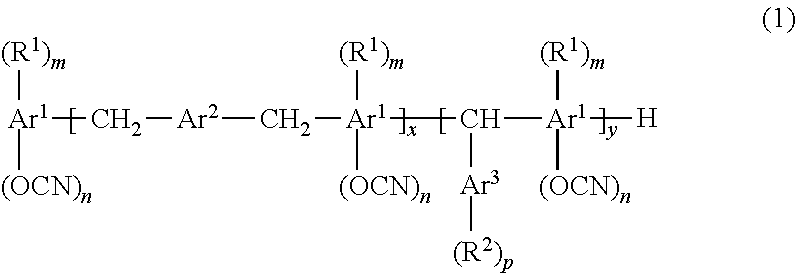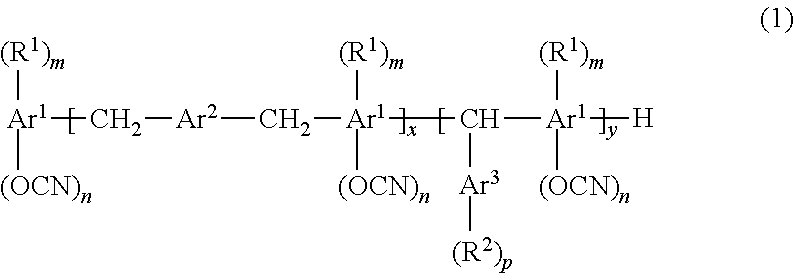Resin composition for printed wiring board, prepreg, metal foil-clad laminate, resin composite sheet, and printed wiring board
a technology of resin composite sheet and printed wiring board, which is applied in the direction of synthetic resin layered products, applications, etc., can solve the problems of high water absorption rate of the obtained cured product, insufficient cyanate compound cured, etc., to achieve and excellent low water absorption
- Summary
- Abstract
- Description
- Claims
- Application Information
AI Technical Summary
Benefits of technology
Problems solved by technology
Method used
Image
Examples
synthesis example 1
Synthesis of Cyanate Compound 1 of Hydroxyl Group-Containing Aromatic Compound (Following General Formula (5)) Obtained by Polycondensing Aromatic Alcohol, Aromatic Aldehyde Compound, and Aralkyl Compound
[0128]
wherein m was 1, whereas n was 1.4.
[0129]370 g of a hydroxyl group-containing aromatic compound 1 represented by formula (6) (manufactured by AIR WATER INC., SK HE510, OH group equivalent 151 g / eq.) and 372.1 g (3.68 mol) (1.5 mol based on 1 mol of hydroxy groups) of triethylamine were dissolved in 2280 g of dichloromethane, and this solution was a solution 1.
[0130]While 334.6 g (5.44 mol) (2.2 mol based on 1 mol of hydroxy groups) of cyanogen chloride, 780.8 g of dichloromethane, 523.2 g (5.17 mol) (2.1 mol based on 1 mol of hydroxy groups) of 36% hydrochloric acid, and 3233.4 g of water were stirred, and the liquid temperature was kept at −2 to −0.5° C., the solution 1 was poured over 50 minutes. After completion of pouring of the solution 1, the mixture was stirred at the s...
synthesis example 2
Synthesis of Cyanate Compound 2 of Hydroxyl Group-Containing Aromatic Compound (Following General Formula (7)) Obtained by Polycondensing Aromatic Alcohol, Aromatic Aldehyde Compound, and Aralkyl Compound
[0133]
wherein m was 1, whereas n was 1.2.
[0134]440 g of the target cyanate compound 2 represented by general formula (7) (brown viscous material) was obtained as in Synthesis Example 1 except that 450 g of a hydroxyl group-containing aromatic compound 2 represented by formula (8) (manufactured by AIR WATER INC., SK HE610, OH group equivalent 184 g / eq.) was used instead of the hydroxyl group-containing aromatic compound 1 represented by formula (6). The number average molecular weight Mn of the obtained cyanate compound 2 was 377.
wherein m was 1, whereas n was 0.9.
example 1
[0135]50 parts by mass of the cyanized ester resin represented by general formula (5) obtained by Synthesis Example 1, 50 parts by mass of a biphenyl aralkyl-based epoxy resin (NC-3000-FH, manufactured by Nippon Kayaku Co., Ltd.), 100 parts by mass of fused silica (SC2050 MB, manufactured by Admatechs Company Limited), and 0.05 parts by mass of zinc octylate (manufactured by Nihon Kagaku Sangyo Co., Ltd.) were mixed to obtain a varnish. This varnish was diluted with methyl ethyl ketone, and an E-glass woven fabric having a thickness of 0.1 mm was impregnated and coated with the diluted varnish and heated and dried at 150° C. for 5 minutes to obtain a prepreg having a resin content of 50% by mass.
[0136]Eight of the obtained prepregs were stacked, and 12 μm thick electrolytic copper foil (JDLCN, manufactured by JX NIPPON MINING & METALS CORP.) was disposed on the top and the bottom. The stack was laminate-molded at a pressure of 30 kgf / cm2 and a temperature of 220° C. for 120 minutes ...
PUM
| Property | Measurement | Unit |
|---|---|---|
| temperature | aaaaa | aaaaa |
| thickness | aaaaa | aaaaa |
| thickness | aaaaa | aaaaa |
Abstract
Description
Claims
Application Information
 Login to View More
Login to View More - R&D
- Intellectual Property
- Life Sciences
- Materials
- Tech Scout
- Unparalleled Data Quality
- Higher Quality Content
- 60% Fewer Hallucinations
Browse by: Latest US Patents, China's latest patents, Technical Efficacy Thesaurus, Application Domain, Technology Topic, Popular Technical Reports.
© 2025 PatSnap. All rights reserved.Legal|Privacy policy|Modern Slavery Act Transparency Statement|Sitemap|About US| Contact US: help@patsnap.com



